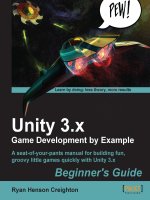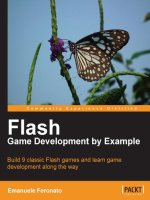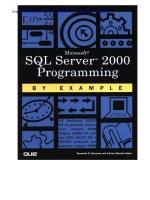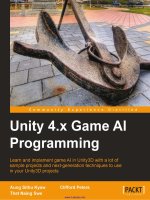programming game ai by example - mat buckland
Bạn đang xem bản rút gọn của tài liệu. Xem và tải ngay bản đầy đủ của tài liệu tại đây (11.54 MB, 521 trang )
TLFeBOOK
Programming Game
AI by Example
Mat Buckland
Wordware Publishing, Inc.
TLFeBOOK
Library of Congress Cataloging-in-Publication Data
Buckland, Mat.
Programming game AI by example / by Mat Buckland.
p. cm.
Includes index.
ISBN 1-55622-078-2 (pbk.)
1. Computer games—Design. 2. Computer games—Programming. 3. Computer
graphics. I. Title.
QA76.76.C672B85 2004
794.8'1526—dc22 2004015103
© 2005, Wordware Publishing, Inc.
All Rights Reserved
2320 Los Rios Boulevard
Plano, Texas 75074
No part of this book may be reproduced in any form or by any means
without permission in writing from Wordware Publishing, Inc.
Printed in the United States of America
ISBN 1-55622-078-2
10987654321
0409
Black & White, the Black & White logo, Lionhead, and the Lionhead logo are registered trademarks of Lionhead Studios
Limited. Screenshots used with the permission of Lionhead Studios Limited. All rights reserved.
Impossible Creatures and Relic are trademarks and/or registered trademarks of Relic Entertainment, Inc.
NEVERWINTER NIGHTS © 2002 Infogrames Entertainment, S.A. All Rights Reserved. Manufactured and marketed by
Infogrames, Inc., New York, NY. Portions © 2002 BioWare Corp. BioWare and the BioWare Logo are trademarks of BioWare
Corp. All Rights Reserved. Neverwinter Nights is a trademark owned by Wizards of the Coast, Inc., a subsidiary of Hasbro, Inc.
and is used by Infogrames Entertainment, S.A. under license. All Rights Reserved.
Unreal® Tournament 2003©2003 Epic Games, Inc. Unreal is a registeredtrademark of Epic Games, Inc. All rightsreserved.
Other brand names and product names mentioned in this book are trademarks or service marks of their respective companies.
Any omission or misuse (of any kind) of service marks or trademarks should not be regarded as intent to infringe on the property
of others. The publisher recognizes and respects all marks used by companies, manufacturers, and developers as a means to
distinguish their products.
This book is soldas is, without warranty of anykind, either express or implied, respectingthe contents of this book andany disks
or programs that may accompany it, including but not limited to implied warranties for the book’s quality, performance,
merchantability, or fitness for any particular purpose. Neither Wordware Publishing, Inc. nor its dealers or distributors shall be
liable to the purchaser or any other person or entity with respect to any liability, loss, or damage caused or alleged to have been
caused directly or indirectly by this book.
All inquiries for volume purchases of this book should be addressed to Wordware Publishing, Inc.,
at the above address. Telephone inquiries may be made by calling:
(972) 423-0090
TLFeBOOK
Dedication
For Mum and Dad, who bought me my first computer, and therefore must
share some responsibility for turning me into the geek that I am. J
iii
TLFeBOOK
“Programming Game AI by Example stands out from the pack by providing indus-
trial-strength solutions to difficult problems, like steering and goal-oriented
behavior. Mat guides the reader toward building a foundation robust enough for
real games. This book is a must-have for anyone new to the field, and has tips for
the seasoned professional as well. I wish I [had] read it eight years ago!”
Jeff Orkin
AI architect, Monolith Productions, No One Lives Forever 2 and F.E.A.R.
“…a nice combination of a lot of really useful information, put together in a way
that doesn’t make my brain leak.”
Gareth Lewis
Project leader, Lionhead Studios, Black & White 2
“Each chapter of Mat’s book gently introduces the reader to a fundamental game
AI technology before expanding the new idea into a fully formed solution replete
with extensive code and clearly worded examples. The tone of the book is uncom-
plicated and accessible to the reader, allowing a novice programmer the
opportunity to get to grips with the basics of game AI programming by implement-
ing their own systems direct from theory or expanding upon code examples offered
to gain understanding in a sandbox environment. Once individual technologies are
fully understood, the book goes on to combine these ideas into several complete
game environments allowing the reader to understand the relationships between the
interacting systems of an overarching game architecture.”
Mike Ducker
AI programmer, Lionhead Studios, Fable
“Using easy-to-follow and well-described examples, this book shows you how to
use most of the techniques professional AI programmers use. A great introduction
for the beginner and an excellent reference for the more experienced!”
Eric Martel
AI programmer, Ubisoft, Far Cry (XBox)
“Programming Game AI by Example is an excellent book for the game program-
ming neophyte, the intermediate programmer, and even the expert — it doesn’t
hurt to go over familiar ground, does it? The book concisely covers all of the
important areas, including basic maths and physics through to graph theory and
scripting with Lua, to arm any programmer with the tools needed to create some
very sophisticated agent behaviours. Unusually for books of the type, Pro-
gramming Game AI by Example is solid in its software engineering too, with the
example code demonstrating game uses of familiar design patterns. I’d have no
qualms about recommending Programming Game AI by Example to any program-
mer. It’s an excellent read and an excellent springboard for ideas.”
Chris Keegan
Technical director, Climax Studios (Solent)
TLFeBOOK
Contents
Foreword xiii
Acknowledgments xvii
Introduction xix
Chapter 1 A Math and Physics Primer 1
Mathematics 1
Cartesian Coordinates 1
Functions and Equations 3
Exponents and Powers 5
Roots of Numbers (Radicals) 6
Simplifying Equations 7
Trigonometry 10
Rays and Line Segments 10
Angles 11
Triangles 12
Vectors 18
Adding and Subtracting Vectors 19
Multiplying Vectors 20
Calculating the Magnitude of a Vector 20
Normalizing Vectors 21
Resolving Vectors 22
The Dot Product 23
A Practical Example of Vector Mathematics 24
The Vector2D Struct 25
Local Space and World Space 26
Physics 28
Time 28
Distance 29
Mass 29
Position 30
Velocity 30
Acceleration 32
Force 38
Summing Up 40
Chapter 2 State-Driven Agent Design 43
What Exactly Is a Finite State Machine? 44
Implementing a Finite State Machine 45
State Transition Tables 47
Embedded Rules 48
The West World Project 50
v
TLFeBOOK
The BaseGameEntity Class 52
The Miner Class 53
The Miner States 54
The State Design Pattern Revisited 55
The EnterMineAndDigForNugget State 60
Making the State Base Class Reusable 62
Global States and State Blips 63
Creating a State Machine Class 64
Introducing Elsa 67
Adding Messaging Capabilities to Your FSM 69
The Telegram Structure 70
Miner Bob and Elsa Communicate 71
Message Dispatch and Management 71
The MessageDispatcher Class 73
Message Handling 75
Elsa Cooks Dinner 78
Step One 78
Step Two 79
Step Three 80
Step Four 80
Step Five 81
Summing Up 82
Chapter 3 How to Create Autonomously Moving Game Agents 85
What Is an Autonomous Agent? 85
The Vehicle Model 87
Updating the Vehicle Physics 89
The Steering Behaviors 91
Seek 91
Flee 92
Arrive 93
Pursuit 94
Evade 96
Wander 96
Obstacle Avoidance 99
Finding the Closest Intersection Point 100
Calculating the Steering Force 103
Wall Avoidance 104
Interpose 106
Hide 107
Path Following 110
Offset Pursuit 111
Group Behaviors 113
Separation 115
Alignment 116
Cohesion 117
Flocking 118
Combining Steering Behaviors 119
Weighted Truncated Sum 120
Weighted Truncated Running Sum with Prioritization 121
vi | Contents
TLFeBOOK
Prioritized Dithering 123
Ensuring Zero Overlap 124
Coping with Lots of Vehicles: Spatial Partitioning 126
Smoothing 130
Chapter 4 Sports Simulation — Simple Soccer 133
The Simple Soccer Environment and Rules 134
The Soccer Pitch 135
The Goals 138
The Soccer Ball 138
SoccerBall::FuturePosition 141
SoccerBall::TimeToCoverDistance 142
Designing the AI 144
The SoccerTeam Class 145
The Receiving Player 146
The Closest Player to the Ball 146
The Controlling Player 146
The Supporting Player 146
SoccerTeam States 152
Field Players 155
Field Player Motion 155
Field Player States 156
Goalkeepers 170
Goalkeeper Motion 170
Goalkeeper States 171
Key Methods Used by the AI 176
SoccerTeam::isPassSafeFromAllOpponents 177
SoccerTeam::CanShoot 182
SoccerTeam::FindPass 184
SoccerTeam::GetBestPassToReceiver 185
Making Estimates and Assumptions Work for You 189
Summing Up 189
Chapter 5 The Secret Life of Graphs 193
Graphs 193
A More Formal Description 195
Trees 196
Graph Density 196
Digraphs 196
Graphs in Game AI 197
Navigation Graphs 198
Dependency Graphs 199
State Graphs 201
Implementing a Graph Class 203
The GraphNode Class 204
The GraphEdge Class 205
The SparseGraph Class 207
Graph Search Algorithms 209
Uninformed Graph Searches 210
Depth First Search 210
Contents | vii
TLFeBOOK
Breadth First Search 224
Cost-Based Graph Searches 231
Edge Relaxation 231
Shortest Path Trees 233
Dijkstra’s Algorithm 233
Dijkstra with a Twist: A* 241
Summing Up 247
Chapter 6 To Script, or Not to Script, That Is the Question 249
Just What Is a Scripting Language? 249
What a Scripting Language Can Do for You 251
Dialogue Flow 253
Stage Direction 254
AI Logic 255
Scripting in Lua 255
Setting Up Your Compiler to Work with Lua 256
Getting Started 256
Lua Variables 258
Lua Types 260
Logical Operators 263
Conditional Structures 264
Rock-Paper-Scissors in Lua 265
Interfacing with C/C++ 268
Accessing Lua Global Variables from within Your C++ Program 269
Accessing a Lua Table from within Your C++ Program 271
Accessing a Lua Function from within C++ 273
Exposing a C/C++ Function to Lua 274
Exposing a C/C++ Class to Lua 276
Luabind to the Rescue! 276
Setting Up Luabind 276
Scopes 277
Exposing C/C++ Functions Using Luabind 278
Exposing C/C++ Classes Using Luabind 279
Creating Classes in Lua Using LuaBind 281
luabind::object 282
Creating a Scripted Finite State Machine 285
How It Works 285
The States 289
GoHome 290
Sleep 290
GoToMine 291
Useful URLS 292
It Doesn’t All Smell of Roses 292
Summing Up 293
Chapter 7 Raven: An Overview 295
The Game 295
Overview of the Game Architecture 296
The Raven_Game Class 297
The Raven Map 299
viii | Contents
TLFeBOOK
Raven Weapons 301
Projectiles 302
Triggers 303
TriggerRegion 304
Trigger 305
Respawning Triggers 307
Giver-Triggers 308
Limited Lifetime Triggers 309
Sound Notification Triggers 310
Managing Triggers: The TriggerSystem Class 311
AI Design Considerations 313
AI Implementation 315
Decision Making 315
Movement 315
Path Planning 315
Perception 316
Target Selection 321
Weapon Handling 323
Putting It All Together 327
Updating the AI Components 328
Summing Up 331
Chapter 8 Practical Path Planning 333
Navigation Graph Construction 333
Tile Based 333
Points of Visibility 334
Expanded Geometry 335
NavMesh 335
The Raven Navigation Graph 336
Coarsely Granulated Graphs 336
Finely Grained Graphs 339
Adding Items to the Raven Navigation Graph 341
Using Spatial Partitioning to Speed Up Proximity Queries 342
Creating a Path Planner Class 342
Planning a Path to a Position 344
Planning a Path to an Item Type 346
Paths as Nodes or Paths as Edges? 348
An Annotated Edge Class Example 350
Modifying the Path Planner Class to Accommodate Annotated Edges 350
Path Smoothing 353
Path Smoothing Rough but Quick 354
Path Smoothing Precise but Slow 358
Methods for Reducing CPU Overhead 359
Precalculated Paths 359
Precalculated Costs 361
Time-Sliced Path Planning 363
Hierarchical Pathfinding 372
Getting Out of Sticky Situations 374
Summing Up 376
Contents | ix
TLFeBOOK
Chapter 9 Goal-Driven Agent Behavior 379
The Return of Eric the Brave 380
Implementation 382
Goal_Composite::ProcessSubgoals 385
Goal_Composite::RemoveAllSubgoals 386
Examples of Goals Used by Raven Bots 387
Goal_Wander 387
Goal_TraverseEdge 388
Goal_FollowPath 391
Goal_MoveToPosition 393
Goal_AttackTarget 395
Goal Arbitration 398
Calculating the Desirability of Locating a Health Item 400
Calculating the Desirability of Locating a Specific Weapon 401
Calculating the Desirability of Attacking the Target 403
Calculating the Desirability of Exploring the Map 403
Putting It All Together 404
Spin-offs 405
Personalities 405
State Memory 406
Example One — Automatic Resuming of Interrupted Activities 407
Example Two — Negotiating Special Path Obstacles 408
Command Queuing 410
Using the Queue to Script Behavior 412
Summing Up 414
Chapter 10 Fuzzy Logic 415
Crisp Sets 417
Set Operators 418
Fuzzy Sets 419
Defining Fuzzy Boundaries with Membership Functions 419
Fuzzy Set Operators 421
Hedges 423
Fuzzy Linguistic Variables 423
Fuzzy Rules 424
Designing FLVs for Weapon Selection 425
Designing the Desirability FLV 426
Designing the Distance to Target FLV 427
Designing the Ammo Status FLV 428
Designing the Rule Set for Weapon Selection 428
Fuzzy Inference 429
Rule One 429
Rule Two 430
Rule Three 430
Defuzzification 433
From Theory to Application: Coding a Fuzzy Logic Module 437
The FuzzyModule Class 437
The FuzzySet Base Class 439
The Triangular Fuzzy Set Class 440
The Right Shoulder Fuzzy Set Class 441
x | Contents
TLFeBOOK
Creating a Fuzzy Linguistic Variable Class 443
Designing Classes for Building Fuzzy Rules 445
How Raven Uses the Fuzzy Logic Classes 451
The Combs Method 452
Fuzzy Inference and the Combs Method 454
Implementation 455
Summing Up 455
Last Words 457
Appendix A C++ Templates 459
Appendix B UML Class Diagrams 465
Appendix C Setting Up Your Development Environment 475
References 477
Bugs and Errata 479
Index 481
Contents | xi
TLFeBOOK
This page intentionally left blank.
TLFeBOOK
Foreword
Draw the blinds. Turn off the TV set. Shut off your cell phone. Turn on a
little background music. Pour yourself a cup of your favorite “program-
mer’s drink,” and find yourself a nice, cozy chair with your favorite laptop
close at hand. You’re about to go a-learnin’.
Welcome to Programming Game AI by Example.
I must confess I was surprised when Mat contacted me back in 2003
about this book. I wondered to myself, “He already covered all of the new
techniques pretty well…what more is there to do?”
As we exchanged emails Mat expressed that he had a simple desire to
follow up on his first book, AI Techniques for Game Programming, with
something having a completely different focus. Whereas Techniques
explored the more “exotic” biological technologies that a game AI pro-
grammer might be wondering about without bogging down in computer
science minutiae, Mat wanted Example to focus more on what technologies
are actually being used by most game AI programmers in their day-to-day
work. New technologies and new approaches are always to be considered
when it makes sense to do so of course, but developers must always have
the basics at hand to build a firm foundation for any game AI engine.
That’s what this book is all about.
The Surge of Game AI’s Importance
Game AI has undergone a quiet revolution in the past few years. No longer
is it something that most developers consider only toward the end of a pro-
ject when shipping deadlines loom and the publisher is pushing to have the
game ship before the next holiday milestone. Now game AI is something
that is planned for, something that developers are deliberately making as
important a part of a game’s development as the graphics or the sound
effects. The market is rife with games of all kinds and developers are look-
ing for every edge they can get to help their game get noticed. A game with
truly smart opponents or non-player characters is one that gets noticed
automatically, no matter what it looks like.
We’ve seen this in the enormous growth in books on the subject, in the
surge in attendance at the Game Developers Conference AI roundtables,
and in the explosion of game AI web sites across the Internet. Where a few
years ago there were only a handful of books that covered AI techniques in
xiii
TLFeBOOK
terms that a programmer could understand, there are now dozens. Where a
few years ago we weren’t at all sure we could fill a single room at the GDC
with people interested in talking about the techniques they used to build
game AI engines, we now have to turn people away; we just can’t fit
everybody in the sessions. Where there were once only a small — very
small — number of web pages dedicated to game AI on the Internet, there
are now more than I can easily count; a quick Google search as I write this
showed over a hundred dedicated in whole or in part to the topic. Amazing,
absolutely amazing.
And every one of the developers who visits these pages, who comes to
the roundtables, who buys the books is interested in the same things:
n
What techniques do other developers use?
n
What technologies have other developers found useful?
n
What do different games do for AI? Are they all faking it, does
everybody do the same thing, or is there room for improvement?
n
What are the stumbling blocks that others have run into so I’m not
surprised? More importantly, what are the solutions other people
have developed so that I don’t have to?
n
How can I make my AIs smarter?
n Most importantly of all, how can I make my AIs more fun?
This book is for those people. The ones who seek hard, practical examples
and hard, practical answers. There’s more than pure theory here; this book
is about real techniques with real, working examples.
About time, huh?
By Engineers, For Engineers
The most important thing to a good software engineer is to know about
techniques that work and why. Theory is great, but demos and code are
better; a developer can get right into the code and see why something
works and how it might be adapted to his own problem. This is exactly the
kind of thing that game AI developers have been pounding the walls for at
every GDC AI roundtable. And this book delivers exactly this kind of
information, and in spades.
From the initial chapters covering the sturdy finite state machine (FSM)
to the chapters exploring the more exotic areas of fuzzy logic (FL), Mat has
built a text that will serve as a ready reference and source of learning for a
long time to come. Every major technique in use by developers is covered
here, using the context of an innovative agent-based AI engine called
Raven to show how a given approach works and why. Basic reactionary
behaviors are the most obvious ones and Mat covers them in exhaustive
detail, with code showing each evolutionary iteration and demos to help it
all make sense.
xiv | Foreword
TLFeBOOK
Mat doesn’t stop there as many books do, however. Example moves on
to cover deeper approaches such as hierarchical goal-based agents, placing
such technologies in the context of the Raven engine and building on previ-
ous examples to show how they can greatly improve a game’s AI. These
are techniques in use in only a handful of games on the market today, but
they can make a game’s AI truly stand out if done properly. This book will
show you why they make a difference and how to use them. Mat even pro-
vides tips for better implementations than used in his examples and
summarizes potential improvements to the techniques covered. To this end
he offers up the occasional practical exercise to point the interested devel-
oper in ways to make a given technique better, helping readers to focus on
how they might use the technology in their own games. After all, code is
never done, it’s just done enough.
All of this makes Programming Game AI by Example a book I think
you’re really going to find useful. If you’re looking for hard code and real
techniques, for a book that covers what game AI developers are really
doing and how, then this is the book for you.
Have fun.
Steven Woodcock
Foreword | xv
TLFeBOOK
This page intentionally left blank.
TLFeBOOK
Acknowledgments
A huge thanks to Steve Woodcock (gameai.com) and Eric Martel (Ubisoft),
who gave up much of their free time to help out with technical reviews of
the text and code, and to Ron Wolfe (Sidney Fire Department), who volun-
teered to be my guinea pig. I owe you guys.
I’d also like to thank Craig Reynolds (Sony), Jeff Hannan
(Codemasters), and William Combs (Boeing) for patiently answering my
questions; and to the team at Wordware for all their expertise.
Thanks also to my old friend Mark Drury for checking over the math
and physics chapter.
Finally, a big thank you and hug to my partner and best friend, Sharon,
for the many hours she spent proofreading, and for all the times I must
have stared vacantly at her moving lips whilst my mind was off visiting
another planet. I don’t know how she puts up with me.
xvii
TLFeBOOK
This page intentionally left blank.
TLFeBOOK
Introduction
The objective of the book you hold in your hands is to provide a solid and
practical foundation to game AI, giving you the confidence to approach
new challenges with excitement and optimism. AI is an enormous topic, so
don’t expect to come away from this book an expert, but you will have
learned the skills necessary to create entertaining and challenging AI for
the majority of action game genres. Furthermore, you will have a sound
understanding of the key areas of game AI, providing a solid base for any
further learning you undertake. And let me tell you, the learning process is
endless!
Being a good game AI programmer is not just about knowing how to
implement a handful of techniques. Of course, individual techniques are
important, but how they can be made to work together is more vital to the
AI development process. To this end, this book spends a lot of time walk-
ing you through the design of agents capable of playing a team sports game
(Simple Soccer) and a deathmatch type shoot-’em-up (Raven), demonstrat-
ing clearly how each technique is used and integrated with others.
Furthermore, Simple Soccer and Raven provide a convenient test bed for
further experimentation, and within the conclusions of many of the chap-
ters are suggestions for future exploration.
Academic AI vs. Game AI
There is an important distinction to be made between the AI studied by
academics and that used in computer games. Academic research is split
into two camps: strong AI and weak AI. The field of strong AI concerns
itself with trying to create systems that mimic human thought processes
and the field of weak AI (more popular nowadays) with applying AI tech-
nologies to the solution of real-world problems. However, both of these
fields tend to focus on solving a problem optimally, with less emphasis on
hardware or time limitations. For example, some AI researchers are per-
fectly happy to leave a simulation running for hours, days, or even weeks
on their 1000-processor Beowolf cluster so long as it has a happy ending
they can write a paper about. This of course is an extreme case, but you get
my point.
Game AI programmers, on the other hand, have to work with limited
resources. The amount of processor cycles and memory available varies
xix
TLFeBOOK
from platform to platform but more often than not the AI guy will be left,
like Oliver holding out his bowl, begging for more. The upshot of this is
that compromises often have to be made in order to get an acceptable level
of performance. In addition, successful games — the ones making all the
money — do one thing very well: They entertain the player (or they have a
film license J). Ipso facto, the AI must be entertaining, and to achieve this
must more often than not be designed to be suboptimal. After all, most
players will quickly become frustrated and despondent with an AI that
always gives them a whippin’. To be enjoyable, an AI must put up a good
fight but lose more often than win. It must make the player feel clever, sly,
cunning, and powerful. It must make the player jump from his seat shout-
ing, “Take that, you little shit!”
The Illusion of Intelligence
But what is this mysterious thing we call artificial intelligence? With
regard to game AI I am firmly of the opinion that if the player believes the
agent he’s playing against is intelligent, then it is intelligent. It’s that sim-
ple. Our goal is to design agents that provide the illusion of intelligence,
nothing more.
Because the illusion of intelligence is subjective, sometimes this takes
very little effort at all. The designers of the AI for Halo, for instance, dis-
covered their playtesters could be fooled into thinking the AI agents were
more intelligent simply by increasing the number of hit points required to
kill them. For one test session they allowed the agents to die really easily
(low hit points); the result was that 36 percent of the testers thought the AI
was too easy and 8 percent thought the AI were very intelligent. For the
next test session the agents were made harder to kill (higher hit points).
After just this small change 0 percent of the testers thought the AI was too
easy and 43 percent thought the AI was very intelligent! This is an aston-
ishing result and clearly shows the importance of playtesting throughout
the game development cycle.
It has also been shown that a player’s perception of the level of intelli-
gence of a game agent can be considerably enhanced by providing the
player with some visual and/or auditory clues as to what the agent is
“thinking” about. For example, if the player enters a room and startles an
agent, it should act startled. If your game is a “stealth-’em-up” like Thief
and a game character hears something suspicious, then it should start to
look around and maybe mumble a few words such as “What was that?” or
“Is anyone there?” Even something simple like making sure that an agent
tracks the movement of neighboring agents with its head can contribute
significantly to a player’s perception of the AI.
You must be careful though when designing your AI not to let the cloak
of illusion slip, since once it does the player’s belief in the game character
xx | Introduction
TLFeBOOK
will evaporate and the game becomes much less fun to play. This will hap-
pen if the AI is seen to act stupidly (running into walls, getting stuck in
corners, not reacting to obvious stimuli) or is caught “cheating” (seeing
through walls, requiring less gold to build units than the human player,
hearing a pin drop at 500 meters), so you must take great pains to avoid
either of these pitfalls.
A Word about the Code
Writing the accompanying source code for this book has necessitated a few
compromises. For starters, the code must be formatted so each line fits in
the width of the printed page. This seems like common sense, but I’ve seen
many books where the formatting is hideous, with huge gaps and spaces
everywhere, making the code difficult to follow as it meanders about the
page. The bottom line is that, unlike your IDE, the printed page has a fixed
width within which printed code must fit: Each line of code must have a
maximum width of 82 characters. Restricting lines of code to this length
can be challenging, particularly when using the STL and templates together
with descriptive class and variable names. For this reason, I’ve had to keep
several names shorter than I would have liked, but wherever this was nec-
essary, I’ve taken the liberty of being generous with my commenting. You
will also notice in some sections of the code a profusion of temporary vari-
ables. These are here to either make the code clearer to read or to split up
long lines of code so they fit within the 82-character limit, or both.
The code and demo executables that accompany this book can be
downloaded from www.wordware.com/files/ai. Then click on Buckland_
AISource.zip and Buckland_AIExecutables.zip.
Appendix C provides instructions on how to set up your development
environment in order to compile the projects.
Practice Mak es Perfect
As with all skills, the more you practice using AI techniques and designing
AI systems, the better you get. Those of you who have bought this book
because you are already involved in the development of a game’s AI can
get started with what you learn immediately — you already have the per-
fect test bed to practice on. However, for those of you who are not
currently involved in a project, I’ve included “practicals” at the end of
most chapters for you to try your hand at. These encourage you to experi-
ment with the knowledge you’ve learned, either by creating small
stand-alone examples or by altering or building upon the Simple Soccer
or Raven code projects.
Introduction | xxi
TLFeBOOK
This page intentionally left blank.
TLFeBOOK
Chapter 1
A Math and Physics Primer
T
here’s no hiding from it — if you want to learn AI, it helps to know
some mathematics and physics. Sure, you can use many AI techniques
in a “cut and paste” fashion, but that’s not doing yourself any favors; the
moment you have to solve a problem slightly different from the one you’ve
borrowed the code from you’re going to run into difficulties. If you under-
stand the theory behind the techniques, however, you will stand a much
better chance of figuring out an alternative solution. Besides, it feels good
to understand the tools you’re working with. What better reason do you
need to learn this stuff but that?
I’m going to write this chapter assuming you know hardly anything at
all about math or physics. So forgive me if you already know most of it,
but I figure this way I’ll catch everyone, no matter what your experience is.
Skim through the chapter until you come to something you don’t know or
you find a topic where you think your memory needs to be refreshed. At
that point, start reading. If you are already comfortable with vector math
and the physics of motion, I suggest you skip this chapter entirely and
come back later if you find something you don’t understand.
Mathematics
We’ll start with mathematics because trying to learn physics without math
is like trying to fly without wings.
Cartesian Coordinates
You are probably already familiar with the Cartesian coordinate system. If
you’ve ever written a program that draws images to the screen then you
will almost certainly have used the Cartesian coordinate system to describe
the positions of the points, lines, and bitmaps that make up the image.
In two dimensions, the coordinate system is defined by two axes posi-
tioned at right angles to each other and marked off in unit lengths. The
horizontal axis is called the x-axis and the vertical axis, the y-axis. The
point where the axes cross is called the origin. See Figure 1.1.
1
TLFeBOOK
The arrowheads at each end of the axes in Figure 1.1 indicate they extend
in each direction infinitely. If you imagine yourself holding an infinitely
large sheet of paper with the x and y axes drawn on it, the paper represents
the xy plane — the plane on which all points in the two-dimensional Carte-
sian coordinate system can be plotted. A point in 2D space is represented
by a coordinate pair (x, y). The x and y values represent the distances along
each of the respective axes. Nowadays, a series of points or lines plotted on
the Cartesian coordinate system is usually referred to as a graph, which
saves a lot of typing for sure. :o)
Ü
NOTE To represent three-dimensional space, another axis is needed — the
z-axis. The z-axis extends from behind your screen to way behind your head,
passing through the origin en route. See Figure 1.2.
2 | Chapter 1
Mathematics
Figure 1.1. The Cartesian coordinate system
Figure 1.2. A three-axis (3D) coordinate system
TLFeBOOK









